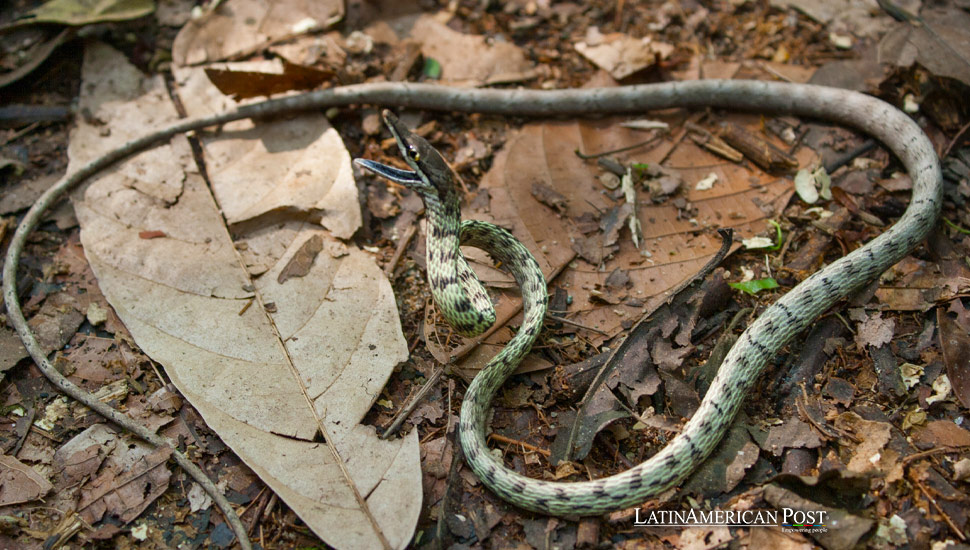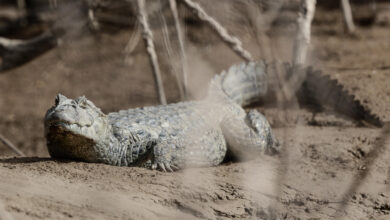Elusive Predator Unveiled in Bolivia’s Dense Forests

An elusive predator has finally emerged from obscurity in the heart of northern Bolivia’s dense forests. This discovery, detailed in a study in Herpetozoa, marks a significant milestone in wildlife research.
A cryptic predator had long evaded human detection in northern Bolivia’s dense forests. The 4-foot-long creature, hidden by its remote habitat and natural camouflage, had remained a mystery—until now. In 2015, scientists ventured into the lowlands of La Paz on a mission to survey wildlife, an expedition documented in a study published on July 10 in the peer-reviewed journal Herpetozoa. They aimed to find elusive reptiles, specifically vine snakes and sharpnose snakes.
Accidental Discovery
During this ambitious expedition, a wildlife guide, while clearing a trail near the camp, accidentally severed a 4-foot-long snake. This unintentional discovery piqued the researchers’ interest. Upon closer inspection, they identified the snake as the country’s first record of Oxybelis inkaterra, or Inkaterra vine snake. A photo accompanying the study shows the Inkaterra vine snake looped over a branch, its coloration—a blend of grays, creams, and light browns—providing perfect camouflage. Its head, distinctly pointy, contributes to its cryptic nature.
The researchers theorized that the snake likely felt threatened by the hiker and remained motionless to avoid detection, mimicking a branch. While effective against natural predators, this behavior rendered it invisible to the guide, resulting in an unfortunate accident. The study highlighted this discovery and detailed the presence of the Inkaterra vine snake in Peru and Ecuador. Additionally, museum archives revealed two more specimens: one caught in Bolivia in 2005 and another with undetermined date and location information.
Habitat and Characteristics
The region of La Paz, where the snake was found, is situated in northwestern Bolivia, close to the Peruvian border. Vine snakes, known for their cryptic nature, are characterized by their coloration, elongated heads, slender bodies, and long tails. These physical traits, combined with their behavioral patterns, make them particularly difficult to observe and capture. Their diet includes a variety of small vertebrates, such as lizards, birds, amphibians, and mammals, emphasizing their role as integral predators in their ecosystem.
The research team, comprising Luis Rivas, Gustavo Rey-Ortíz, Cord Eversole, Randy Powell, Gonzalo Navarro-Cornejo, Edson Cortez, Mauricio Ocampo, Gabriel Callapa, and Arturo Muñoz, documented not only the Inkaterra vine snake but also several other poorly known snake species. This discovery and subsequent research underscore the importance of continued exploration and study in remote regions, where many species remain undiscovered and undocumented.
Significance of the Discovery
The accidental discovery of the Inkaterra vine snake sheds light on the rich biodiversity hidden within Bolivia’s forests. With its remarkable camouflage, this elusive predator exemplifies scientists’ challenges in studying wildlife in such remote and dense habitats. The finding also raises awareness about the delicate balance of these ecosystems and the impact human activities can have, even unintentionally.
The story of the Inkaterra vine snake reminds us of the vast unknowns in the natural world. Each discovery, whether accidental or deliberate, contributes to our understanding of the intricate web of life that thrives in these remote regions. As researchers continue to explore and document these areas, they uncover new species and gather crucial data that can inform conservation efforts and help protect these fragile ecosystems.
Also read: Bolivian Cholitas’ Resilience Amidst Vanishing Andean Glaciers
The discovery of the Inkaterra vine snake in Bolivia is a testament to wildlife’s resilience and adaptability in the face of human encroachment. It highlights the importance of preserving these habitats and the need for ongoing research to uncover their secrets. As scientists venture further into these uncharted territories, who knows what other hidden treasures they might find? The story of the Inkaterra vine snake is just one chapter in the ever-unfolding narrative of our planet’s incredible biodiversity.





